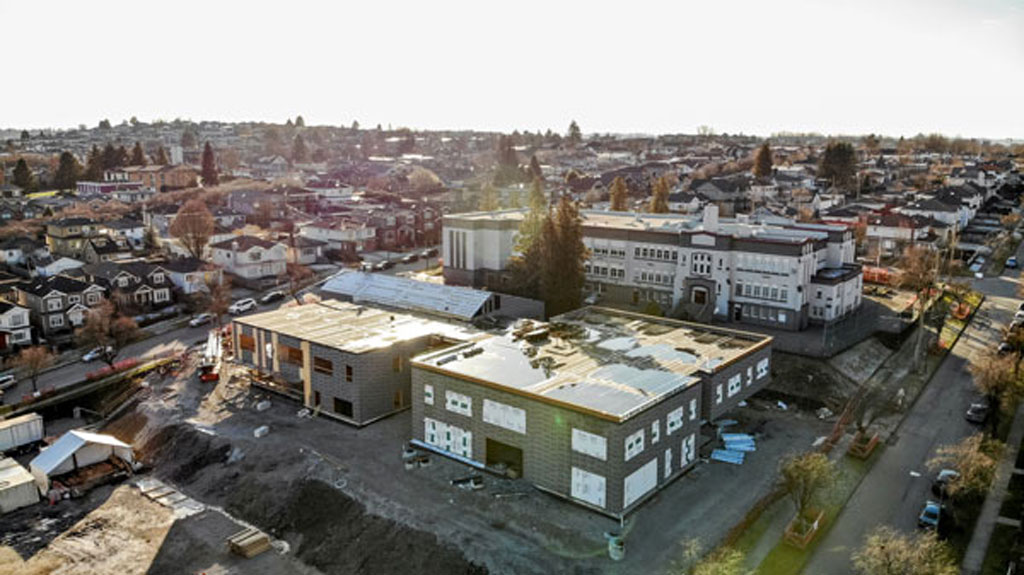British Columbia is the most seismically active area of Canada.
Every year, the province experiences thousands of earthquakes which threaten infrastructure such as schools.
In 2022, roughly 2,500 earthquakes shook the province. Most occurred off the west coast of Vancouver Island and Haida Gwaii.
To mitigate the risk, the province is working through a comprehensive seismic upgrading program of schools across Vancouver and the rest of B.C. to minimize the possibility of a structural collapse if a big one hits.
To date, work has been completed on 213 elementary and secondary schools across the province. Another 13 are under construction and four are proceeding to construction. The plan is to upgrade 496 schools.
Damien Crowell, director of the major capital projects unit of the Ministry of Education and Child Care, says the unique program was developed to address seismic risk and create safe seats for students.
“Seismic upgrades vary widely depending on the specifics of the project,” he says. “With seismic upgrades – often shear walls are installed, new building footings, bracing of unreinforced concrete with new steel stud walls, anchors, exterior bracing with new concrete foundations, upgrading connections between roof and floor diaphragms, etcetera.”
The ministry is working with school districts and Engineers and Geoscientists BC (EGBC) to assess seismic risks to public schools. The EGBC developed Seismic Retrofit Guidelines (SRG) by which all seismic assessments are completed.
“Engineers play a key role in identifying risk and mitigation strategies,” explains Crowell.
Professional engineers, trained in the application of SRGs, assess the risk of damage to a building in the event of an earthquake and apply a seismic risk rating. This rating is the foundation for making decisions about how to mitigate risk in a school building.
Since launching the program, the ministry has spent more than $2 billion to complete high-risk seismic projects throughout the province with another $1.1 billion allocated in its three-year capital plan.
Changes to the 2015 National Building Code (NBC) reflected significantly increased assumptions for ground force motions from a Cascadia Fault subduction event off the west coast. A risk rating was given to each school.
The new guidelines mean some schools that were previously mitigated have been returned to the list for more work. The ministry states the changes reflect a better scientific understanding from seismic experts and the National Research Council to ensure the schools are assessed more accurately.
The ministry is now working closely with school districts to prioritize and sequence seismic mitigation projects so all schools can be mitigated as quickly and efficiently as possible.
Crowell says in some cases seismic upgrades consist mainly of structural upgrades to existing schools while others must be torn down and rebuilt.
The level of assessment varies depending on factors such as when the school was built, he notes.
The latest school to undergo seismic improvements is Henry Hudson Elementary in Vancouver. Construction is underway on a replacement that will include a neighbourhood learning centre that will accommodate 67 care spaces and 20 preschool spaces.
The province has invested approximately $33 million in the project, with the Vancouver School District contributing an additional $1 million. The new school will be seismically safer as well as more accessible, with the inclusion of elevators and parking for people with disabilities.
LEED Gold standards will make the building more energy efficient and reduce greenhouse gas emissions.
Students will remain in the original school while construction is taking place. The new school is expected to be ready to welcome students in spring 2025.
In addition, the City of Vancouver is contributing $11.2 million to create an additional 69 child care spaces at the learning centre for newborns to age four.
Since 2017, the province has spent more than $300 million to seismically upgrade or replace 12 schools in Vancouver. The Vancouver School District has contributed an additional $7.5 million.
The Vancouver projects alone will add approximately 7,000 safe seats to the district. Other seismic replacement projects include Eric Hamber Secondary, Sir Matthew Begbie Elementary, David Lloyd George Elementary and Bayview Community Elementary.
Vancouver School District board chair Victoria Jung says a key priority is to ensure all students attend seismically safe schools as quickly as possible.
Education and Child Care Minister Jennifer Whiteside says she is proud of the work the government is doing in Vancouver and throughout B.C. to invest in seismically safer learning environments for students.
“It’s exciting to see construction start on Henry Hudson Elementary, and with the addition of a neighbourhood learning centre for child care spaces, we will enhance the services and benefits for families and students for years to come.”











Recent Comments
comments for this post are closed